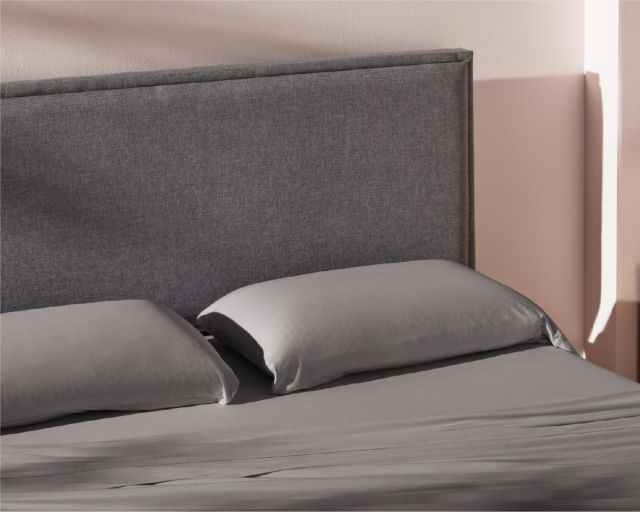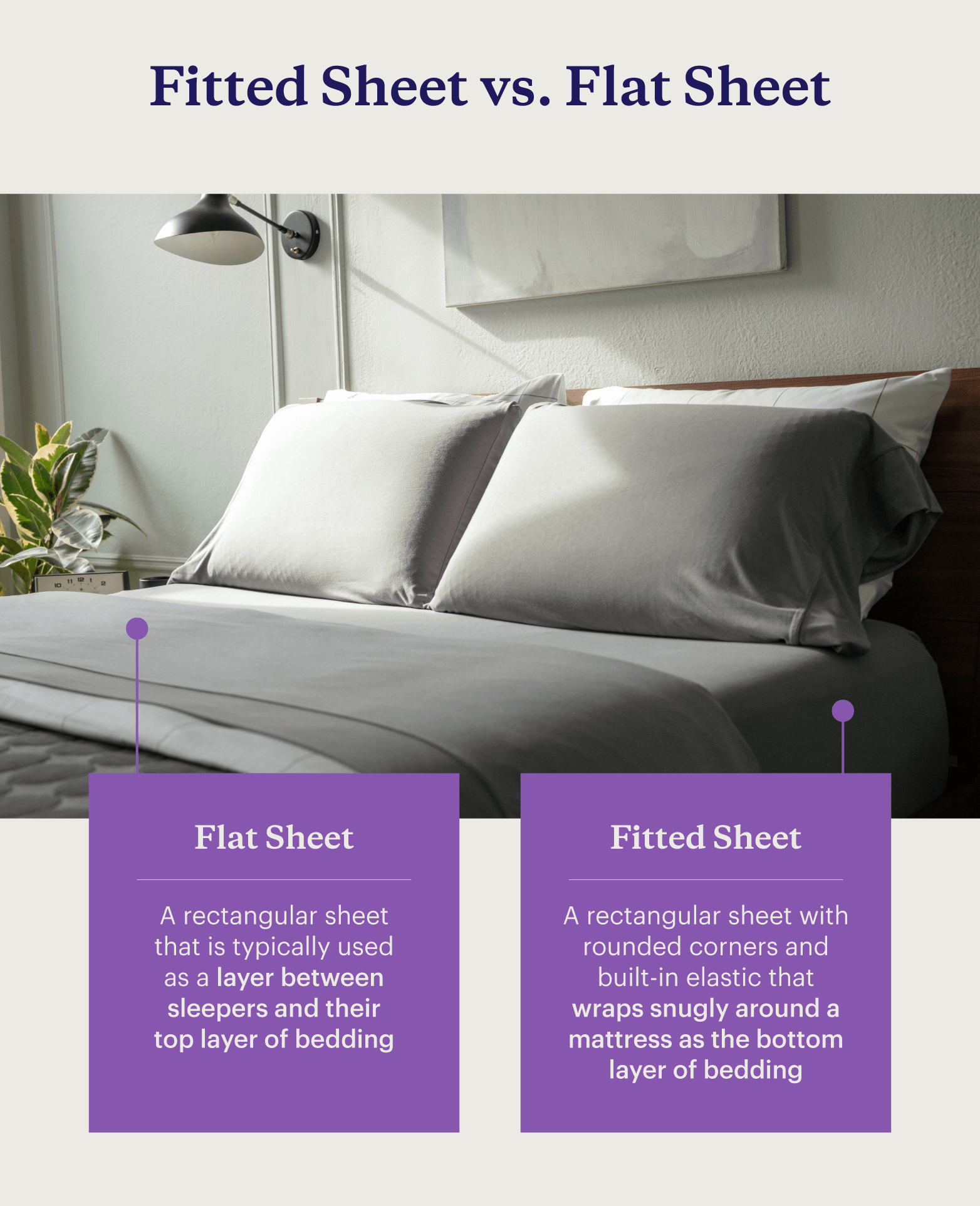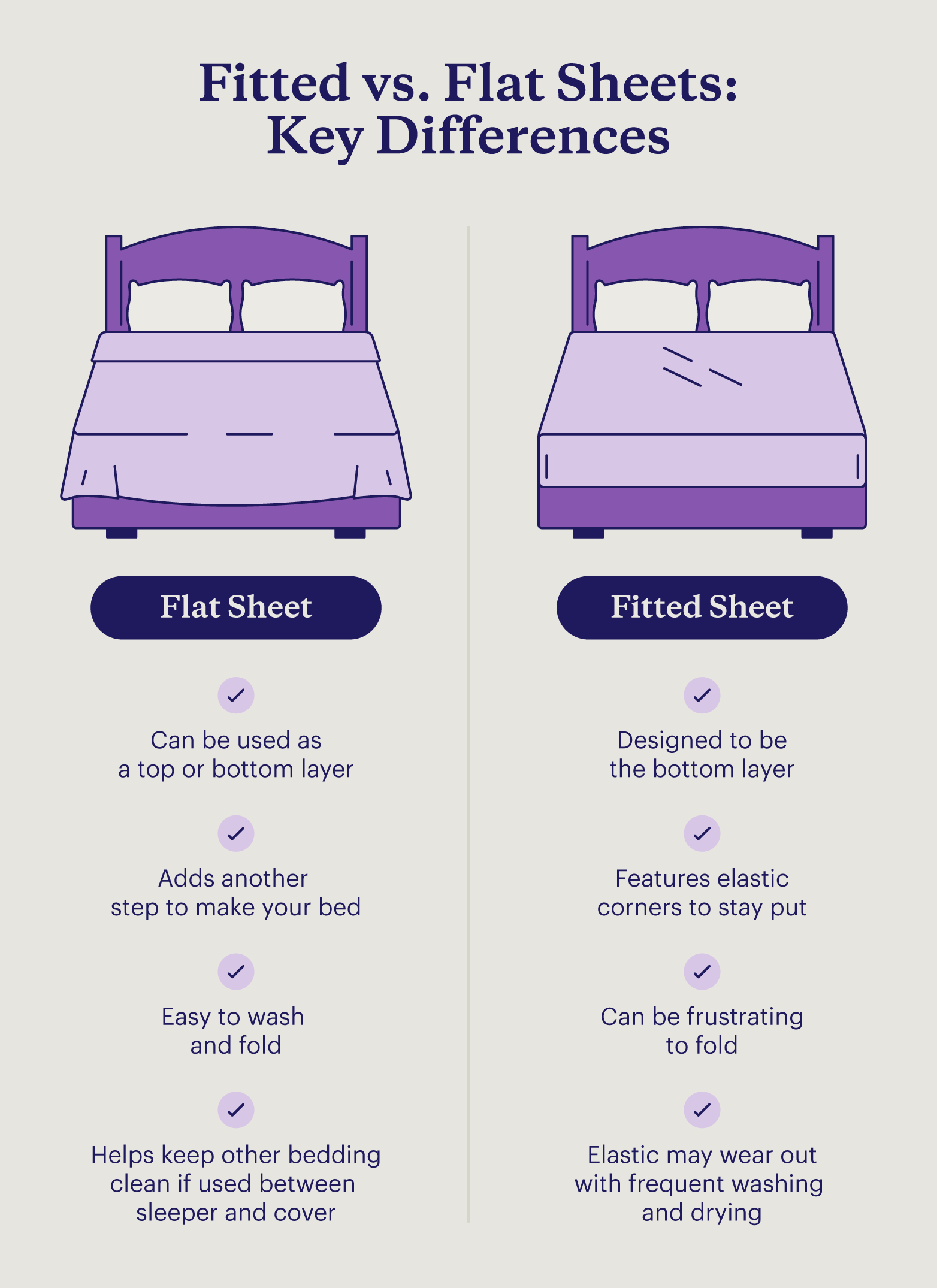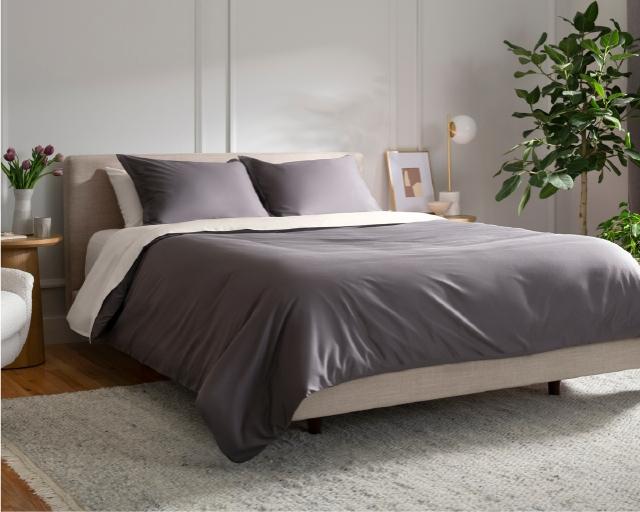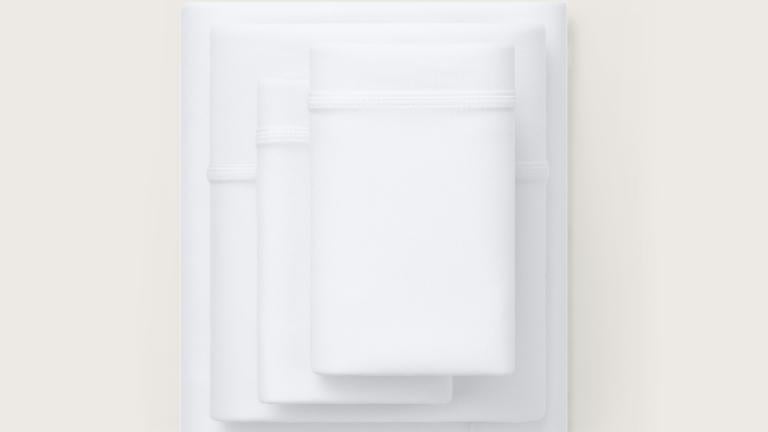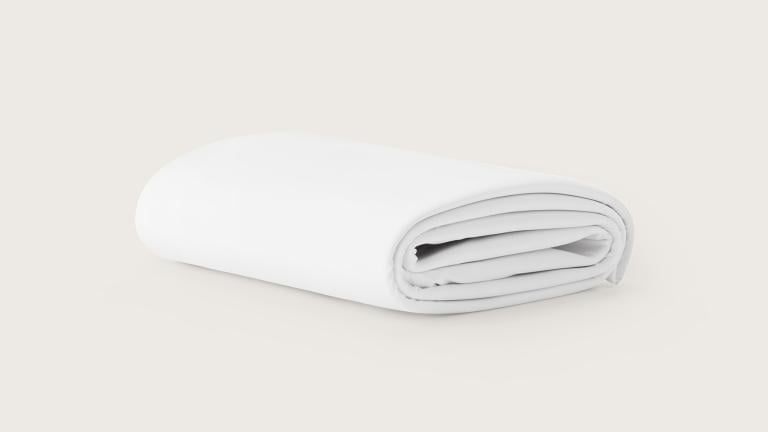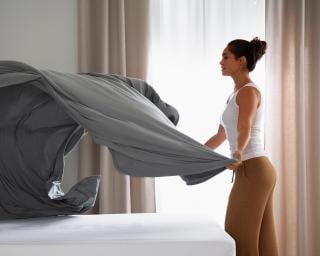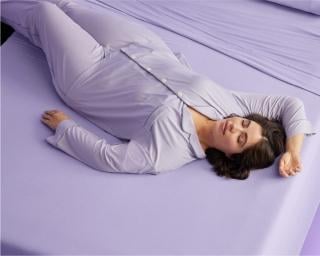Flat Sheet vs. Fitted Sheet: Key Differences + Use Cases
Key Takeaways
- Flat sheets are primarily used on top of a fitted sheet and below a comforter or duvet.
- Fitted sheets are the bottom layer that directly covers and protects the mattress.
- It is recommended to use a fitted sheet as a layer between you and your mattress and a flat sheet between you and your comforter or duvet, but some sleepers prefer to make do without the latter.
When buying bed sheets, many wonder how flat and fitted sheets are different and if both are required. While both cover your bed, they have different purposes and use cases.
Whether it’s time to buy new sheets or you’re simply curious about your options, learning how to use flat and fitted sheets can help you sleep more comfortably.
Read on to learn more about the differences between flat and fitted sheets, when and where to use both types of bed sheets, and the benefits of using both.
What Is a Flat Sheet?
A flat sheet — also known as a top sheet — is a type of non-fitted sheet designed to lie on top of the mattress.
Flat sheets are usually made from lightweight and breathable materials such as cotton, bamboo, linen, or microfiber. These sheets come in different sizes to fit various mattress dimensions and are often sold as part of a sheet set that also includes a fitted sheet, pillowcases, and sometimes a duvet cover.
Flat sheets have a variety of uses beyond simply covering the mattress. They can be layered with other bedding to create warmth and texture or used alone as a lightweight covering during warmer months. They are also easy to wash and care for, making them a practical and versatile addition to any bedding collection.
Benefits of Flat Sheets
Flat sheets can be layered with other bedding or used as a lightweight covering during warmer months. They also provide a soft layer between sleepers and their comforters or duvets, protecting the top layer of bedding from sweat and dead skin. This layer of protection may limit the need to wash the comforter or duvet as frequently.
Flat sheets are typically machine-washable and tend to be less prone to wrinkling than fitted sheets, making them a more practical choice for sleepers who prefer low-maintenance bedding.
What Is a Fitted Sheet?
A fitted sheet is a bed sheet designed to cling onto the corners of a mattress.
Unlike a flat sheet, which is simply draped over and tucked under the foot-end of the mattress, a fitted sheet has elastic corners that grip the mattress, holding the sheet in place and preventing it from slipping. This makes fitted sheets more convenient and less likely to become wrinkled or bunch up at night.
Fitted sheets are available in different sizes to fit all mattress sizes and depths. Common sheet sizes include twin, full, queen, and king sizes, as well as specialized sizes for extra-deep or extra-large mattresses. If you use a mattress protector or mattress topper, a fitted sheet also goes over these layers.
It’s important to choose the correct size fitted sheet to ensure a good fit. A sheet that is too small will not be able to cover the entire mattress. If your fitted sheet is too big for your mattress, the elastic corners won’t hold it in place, so it is more likely to become untucked overnight.
Benefits of Fitted Sheets
So what’s a fitted sheet used for? Fitted sheets are designed to protect your mattress and keep you comfortable. They have elastic corners that hug the mattress tightly, ensuring a secure and snug fit that stays in place throughout the night. This eliminates the need for constant readjustment and helps keep the bed looking neat and tidy.
Additionally, fitted sheets are designed to wrap around the mattress, making them a more effective option than flat sheets. They are also less likely to become tangled or twisted during use, reducing the need for frequent bedding maintenance.
Fitted Sheet vs. Flat Sheet: Key Differences
Flat and fitted sheets are often made from the same types of material, but they aren’t always interchangeable. The differences between fitted and flat sheets are in how they’re used and designed as well as how you should wash and store them.
Intended Use
By design, fitted sheets are meant to be used as a bottom sheet, wrapping around the mattress to protect it from dust, dirt, and sweat. Similarly, the flat sheet is designed to lie on top of the mattress and fitted sheet but under a comforter or duvet.
Versatility
Fitted sheets have one purpose and aren’t suited for other uses because of their distinct shape and design. Flat sheets are more versatile because of their simple rectangular shape.
You can use a flat sheet as a bottom layer by tucking all four corners under your mattress, but you can’t comfortably use a fitted sheet as a top sheet. If you use a flat sheet in place of a fitted sheet, make sure you research how to keep sheets on your bed, like using bed straps to keep them in place.
Design Features
While flat sheets are perfectly rectangular in shape, fitted sheets have rounded corners with elastic to better fit around the corners of your mattress. Flat sheets may have a larger hemmed section on one side, indicating the direction the sheet should lie on your bed.
Fitted and flat sheets are commonly made with the same types of materials, and you can purchase sheet sets that come with uniform flat and fitted sheets as well as pillowcases. The comfort and feel of your sheets heavily depend on the type of sheets you buy, including cotton, Tencel, or bamboo.
Care Instructions
Fitted and flat sheets are usually machine-washable, though you should check specific care instructions for the sheets you use. Over time, fitted sheets may wear out more than flat sheets because repeat washing and drying can reduce elasticity, affecting how snugly the sheet fits on your bed.
Folding and Storage
Fitted sheets are notoriously challenging to fold correctly. There are a few different ways you can fold a fitted sheet, but the rounded corners and elastic make it difficult to fold into a neat rectangle. It’s much easier to fold a flat sheet because of its simple shape and design.
When storing sheets, you can neatly stack folded flat sheets or wrap a matching fitted sheet around a folded flat sheet. Many people find the process of folding fitted sheets tedious and forgo it altogether. Even when folded, fitted sheets may be bulky and lumpy, which can take up more space and look messy.
Which Sheet Is Right for You? When To Use Fitted vs. Flat Sheets
Choosing between a flat sheet or a fitted sheet ultimately comes down to personal preference and specific sleep needs. Consider the following use cases to help you decide when you should use fitted and flat sheets.
Fitted Sheet Use Cases
In most cases, you should use a fitted sheet to keep your mattress clean, though you can use a flat sheet in a similar way. You should consider using a fitted sheet if:
- You want to protect your mattress: Fitted sheets are designed to keep sweat, dirt, dust, and more off your mattress while also providing a soft, comfortable surface for your body. You can use a flat sheet in place of a fitted sheet, but the elastic corners of a fitted sheet help keep this layer in place.
- You have a thicker mattress: Mattress thickness can affect the sheets you use and how well they stay on your bed. For mattresses thicker than 9 to 12 inches, you may need to buy deep-pocket sheets to ensure a proper fit — a fitted deep-pocket sheet will stay on a thicker mattress more securely than a flat sheet used in its place.
- You’re a restless sleeper: If you move around a lot over night, the fitted sheet’s elastic will help keep it in place to protect your mattress from dirt and damage. A flat sheet is more likely to become untucked as you shift positions.
- You don’t want to deal with wrinkled sheets: Fitted sheets wrap snugly around your mattress and maintain a smooth surface thanks to their elastic corners so you don’t have to sleep on a wrinkled sheet.
Flat Sheet Use Cases
Flat sheets are included in sheet sets but using them is optional. You may want to consider using a flat sheet if:
- You want a layer between you and your comforter or duvet: Flat sheets are much easier to wash and dry than thicker layers like blankets, comforters, and duvets. Using a flat sheet under your top layer can catch sweat, oils, and dead skin, keeping your top layer clean.
- You get warm overnight: It may seem counterintuitive, but many sleepers find that sleeping with a flat sheet helps regulate their temperature and keeps them cool. This is especially true if you use cooling sheets like Purple SoftStretch® sheets.
- You don’t move around a lot while you sleep: Instead of a fitted sheet, you can tuck a flat sheet around your mattress, and if you don’t change positions very much throughout the night, the flat sheet should stay put.
- You’ve downsized your bed and don’t want to buy new sheets: Unlike fitted sheets, you can use flat sheets as a bottom layer for mattresses that are smaller than their size. Just tuck the excess under the mattress for a smooth look that also keeps your sheet in place.
- You don’t like folding fitted sheets: Folding a fitted sheet is a fairly minor complaint, but for some people, it’s more than enough reason to do without one. You can use a flat sheet instead, and if you don’t want a sheet under you, it’s best to at least invest in a good mattress protector to ensure your mattress stays clean.
Advantages and Disadvantages of Fitted and Flat Sheets
Bed sheets serve two basic purposes: Protect your mattress and keep you comfortable. If you’re not sure which sheets you should use on your bed, consider common advantages and disadvantages of each type.
Fitted Sheets
Fitted sheets are largely beneficial but come with unique considerations due to their shape, features, and function.
Pros | Cons |
| Elastic corners keep them in place | Notoriously challenging to fold |
| Protects your mattress from dirt and damage | Must match the mattress size exactly or it won’t fit |
| Gives you a soft sleeping surface | May require special care to preserve elasticity |
| Less prone to wrinkling than flat sheets |
Flat Sheets
You’ll find flat sheets in most sheet sets, but some people choose not to use them. In addition to the use cases discussed above, weigh the pros and cons of flat sheets before deciding to use one.
Pros | Cons |
| Can be used as a top or bottom sheet | Adds an extra step to making your bed |
| Can be used as a lighter alternative to a comforter or duvet | May slip out of place more often than a fitted sheet |
| Helps keep your cover clean | May get wrinkled more easily |
| May help you regulate temperature |
Shop Soft and Stretchy Sheets From Purple
At Purple, our bedding sets include a fitted and a flat sheet as well as pillowcases. The Purple SoftStretch® sheet set is made of a silky-smooth bamboo blend fabric that allows for maximum stretchiness and breathability.
If you enjoy a classic cotton feel, our Complete Comfort sheet set is made of a cotton and Spandex blend that feels soft and stretchy simultaneously.
FAQ
Flat sheets are primarily designed to provide an added layer of comfort between you and your duvet or comforter. You can also use a flat sheet as a lightweight, breathable blanket in warmer weather.
If you don’t want to use a fitted sheet, you can swap in a flat sheet and tuck the corners under your mattress to protect it.
A fitted sheet is a piece of bedding designed to cover the mattress, with rounded corners containing elastic used to keep it secure. Fitted sheets provide a comfort layer under you while also protecting your mattress from dirt, dust, and sweat.
Yes, it’s recommended to use both a fitted and flat sheet, but flat sheets are generally considered optional. It’s necessary to use a fitted sheet or other cover beneath you to protect your mattress from dirt, sweat, oils, and dust. Flat sheets offer similar benefits but some sleepers may prefer not to use them for various reasons.
Flat sheets can help keep bulkier bedding items clean. Some flat sheets are a good option if you sleep hot since they can create a breathable barrier between you and heavier bedding. In colder months, some flat sheets made from materials like flannel can help keep you warm. Ultimately, whether you use a flat sheet depends on your preferences.
Typically, yes. The intended purpose of a flat sheet is to lie between you and your top cover, whether it’s a blanket, comforter, or duvet. If you have a flat sheet on your bed as well as a fitted sheet, you will usually sleep between these layers.
Yes, you can use a flat sheet as a blanket. Because they’re thinner than regular blankets, flat sheets can be airier and less stifling. This makes them great for tropical climates or hotter seasons.
Yes, you can technically use a flat sheet as a fitted sheet, though it won’t be as secure as a fitted sheet and is not recommended for long-term use. To do this, you can use sheet clips or straps to keep your flat sheets in place.
Hotels use flat sheets instead of fitted sheets because they are easier to fit onto a hotel bed using hospital corners — a method of securely tucking in flat sheets with crisp folds, originating from 19th-century hospitals — and are simpler to launder and fold. The elastic on fitted sheets can also wear out and lose its stretch with repeated, high-temperature laundering, making them unsuitable for long-term use.
More To Explore
Level up your sleep routine with our most-loved products.


